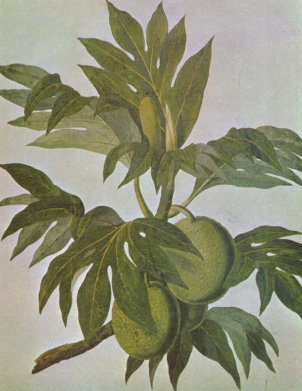I wrote my thoughts earlier on life based on an artificial genome. This being possible because of Mr. Venter's remarkable announcement. So now one can indulge in a bit of footloose fantasy, imaging all kinds of wondrous organisms, that could actually be created.
No dragons or dinosaurs for me please, I'm happy to be in the Holocene; no jurassic time travel for me. But I want to go into that magical world of Enid Blyton in which cakes grew on trees and animals were made of chocolate. Particularly the first one. For here's a scheme to grow a cake-tree.

There's a lovely tree called the wedding-cake tree (Cornus controversa 'Variegata'), named for its tiered canopy that looks like a wedding cake (see upper picture). But I'm looking at its humbler cousin, the breadfruit tree (Artocarpus altilis) (lower picture).
This Polynesian tree that now grows everywhere was once transplanted to the West Indies to feed the slaves and indentured workers on the sugar plantations. One of these ships transporting this tree was the setting for the most famous mutiny in literature - the one on the HMS Bounty.
The exercise succeeded in the short-term objective as Captain Bligh did manage to transport some breadfruit to the Caribbean. However, it failed its long-term objective as the slaves refused to eat the breadfruit. Lucky, a Caribbean Marie Antoinette wasn't there to suggest the consumption of cakefruit.

But what if we could create a cakefruit? An artificial life-form, that produces a fruit that tastes like cake? Well, breadfruit when cooked apparently tastes like bread, whence the name. So perhaps we could build on it through genetic engineering?
What do we put in cakes? Flour, eggs, sugar and butter. The flour is mostly cellulose, which breadfruit already has. Egg is a mix of proteins; wikipedia tells me these three are found in the highest proportions (for egg-white):
Ovalbumin - 54%
Ovotransferrin - 12%
Ovomucoid - 11%
Suppose we clone these three proteins from the chicken genome into an Agrobacterium tumefaciens plasmid. And then use that to finally get the genes into the breadfruit genome, under a promoter that directs expression inside the fruit. We've now got flour and eggs.
Now you want the plant to store a greater amount of sucrose in the fruit, rather than convert it to starch. One could do that expressing the enzyme that joins glucose-1-phosphate to fructose-1-phosphate under a fruit-expressing promoter. And you'll get a GM-breadfruit that now had flour, eggs and sugar.
As for butter, I'm not suggesting anything because I like butter made from milk rather than hydrogenated vegetable oil (margarine). And by this stage
a) the project will have overrun costs and been subjected to budget cuts
b) Greenpeace will have gone crazy about Frankencakes
c) the promoters are not expressing correctly, so it's not tasting like cake-mix
Now all you do is harvest this fruit, pound it to flour, mix it with butter and bake it. I wonder what it will taste like!
No dragons or dinosaurs for me please, I'm happy to be in the Holocene; no jurassic time travel for me. But I want to go into that magical world of Enid Blyton in which cakes grew on trees and animals were made of chocolate. Particularly the first one. For here's a scheme to grow a cake-tree.

There's a lovely tree called the wedding-cake tree (Cornus controversa 'Variegata'), named for its tiered canopy that looks like a wedding cake (see upper picture). But I'm looking at its humbler cousin, the breadfruit tree (Artocarpus altilis) (lower picture).
This Polynesian tree that now grows everywhere was once transplanted to the West Indies to feed the slaves and indentured workers on the sugar plantations. One of these ships transporting this tree was the setting for the most famous mutiny in literature - the one on the HMS Bounty.
The exercise succeeded in the short-term objective as Captain Bligh did manage to transport some breadfruit to the Caribbean. However, it failed its long-term objective as the slaves refused to eat the breadfruit. Lucky, a Caribbean Marie Antoinette wasn't there to suggest the consumption of cakefruit.

But what if we could create a cakefruit? An artificial life-form, that produces a fruit that tastes like cake? Well, breadfruit when cooked apparently tastes like bread, whence the name. So perhaps we could build on it through genetic engineering?
What do we put in cakes? Flour, eggs, sugar and butter. The flour is mostly cellulose, which breadfruit already has. Egg is a mix of proteins; wikipedia tells me these three are found in the highest proportions (for egg-white):
Ovalbumin - 54%
Ovotransferrin - 12%
Ovomucoid - 11%
Suppose we clone these three proteins from the chicken genome into an Agrobacterium tumefaciens plasmid. And then use that to finally get the genes into the breadfruit genome, under a promoter that directs expression inside the fruit. We've now got flour and eggs.
Now you want the plant to store a greater amount of sucrose in the fruit, rather than convert it to starch. One could do that expressing the enzyme that joins glucose-1-phosphate to fructose-1-phosphate under a fruit-expressing promoter. And you'll get a GM-breadfruit that now had flour, eggs and sugar.
As for butter, I'm not suggesting anything because I like butter made from milk rather than hydrogenated vegetable oil (margarine). And by this stage
a) the project will have overrun costs and been subjected to budget cuts
b) Greenpeace will have gone crazy about Frankencakes
c) the promoters are not expressing correctly, so it's not tasting like cake-mix
Now all you do is harvest this fruit, pound it to flour, mix it with butter and bake it. I wonder what it will taste like!
Comments